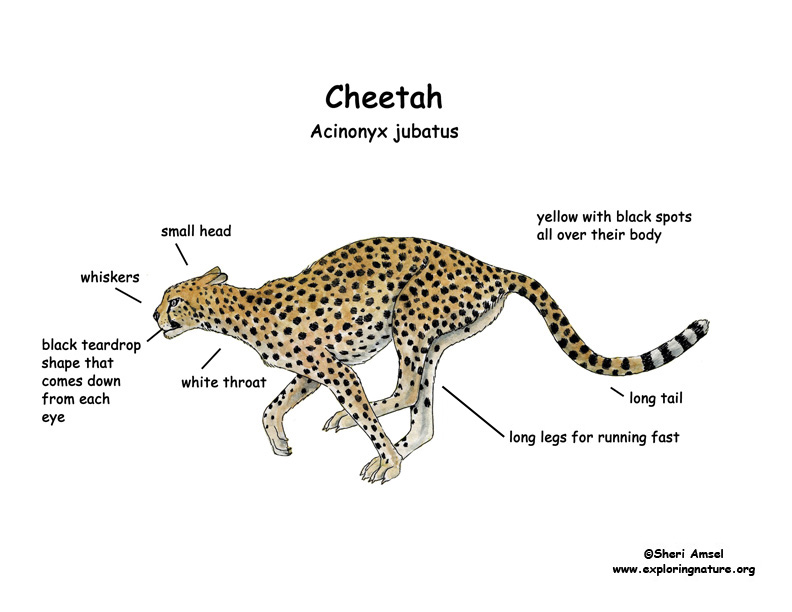

Most cheetahs are found in Africa, but there are a few in parts of Asia.
Cheetahs live mostly on open grasslands and savannahs, but can be found in scrubby, mountain areas and woodlands.
Cheetahs are yellow with black spots all over their body except on their throat, which is white. The cheetah has a black teardrop shape that comes down from each eye and helps it to blend into (camouflage) tall grass. They have a long tail, which helps to balance them when they run. They have a small head for their body size. They can weigh up to 145 pound and are 7 feet long with their tail. They are the only cat that do not have claws that pull in when not in use (retractable). They have very good eyesight for hunting at high speed.
Females usually live alone until it is time to mate, but males form a group with 1-2 other males. They are fast runners. While hunting, a cheetah may reach speeds of 70 mph for a very short time (less than 20 seconds). They are considered the fastest land animal on the world. They hunt during the day.
They eat meat (carnivores). They eat rabbits, gazelles, warthogs, duikers, wildebeest babies and birds.
As cubs, cheetahs are preyed upon by hawks, hyenas, leopards, lions and vultures.
Female cheetahs are pregnant for 13.5 weeks (gestation). They have 3-5 cubs, but usually only 1 in 10 cubs survive to grow up. They care for the cubs themselves and have to leave them alone when they hunt.
They live only 5-6 years in the wild, 12 years or more in captivity. They are listed as "vulnerable".
Kingdom: Animalia
Phylum: Chordata
Subphylum: Vertebrata
Class: Mammalia
Order: Carnivora
Suborder: Feliformia
Family: Felidae
Subfamily: Felinae
Genus: Acinonyx
Species: Acinonyx jubatus
When you research information you must cite the reference. Citing for websites is different from citing from books, magazines and periodicals. The style of citing shown here is from the MLA Style Citations (Modern Language Association).
When citing a WEBSITE the general format is as follows.
Author Last Name, First Name(s). "Title: Subtitle of Part of Web Page, if appropriate." Title: Subtitle: Section of Page if appropriate. Sponsoring/Publishing Agency, If Given. Additional significant descriptive information. Date of Electronic Publication or other Date, such as Last Updated. Day Month Year of access < URL >.
Amsel, Sheri. "Cheetah" Exploring Nature Educational Resource ©2005-2024. December 13, 2024
< http://www.exploringnature.org/db/view/321 >

